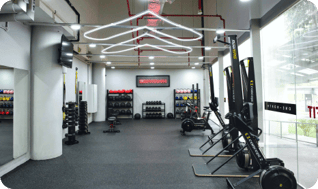Managing musculoskeletal injuries—injuries that affect muscles, bones, and joints, causing persistent pain and limited movement—can be challenging. Often, traditional treatment methods, such as physiotherapy and rest, can not offer the desired relief, and that’s where shockwave therapy comes into play.
UFIT Physiotherapist, Nada Khalid, explains what shockwave therapy is, why and when to use it, and what you can expect from the treatment. Thanks, Nada!
What is shockwave therapy?
Shockwave therapy is a modern, non-invasive treatment gaining popularity for its ability to reduce pain and accelerate recovery rates. During shockwave therapy, radial shockwaves are generated by a projectile fired at high speed from inside a handheld applicator. The applicator is applied to the skin with ultrasound gel, delivering the waves to the damaged tissues, which:
- Increases vascularisation, boosting blood flow to the injured area.
- Facilitates protein synthesis, helping the body create proteins to repair tissue.
- Improve cell proliferation, encouraging the growth of new, healthy cells.
Treatment sessions last about 5 minutes, with a typical course of 4 to 5 sessions as part of a wider rehabilitation programme.
The benefits
Shockwave therapy has several benefits that make it an effective option for those seeking a time-efficient recovery.
Faster healing
One of the main attractions of shockwave therapy is the accelerated healing process. As the shockwaves stimulate blood flow to the damaged tissue, it enhances the delivery of nutrients and oxygen, which are necessary for tissue repair.
Less pain
The shockwaves fired at the damaged tissue interrupt the pain signals transmitted by nerves, promoting the release of endorphins, which are the body’s natural painkillers. This leads to pain reduction and less discomfort when performing daily or sports activities.
Non-invasive
Shockwave therapy eliminates the need for surgery or injections, reducing the risk of complications and the time needed to recover from invasive procedures. It also has a low risk of side effects, with the most common side effect being mild and temporary discomfort at the treatment site.
Versatile
Shockwave therapy can be used to treat a variety of conditions, including plantar fasciitis, Achilles tendinopathy, tennis and golfer's elbow, frozen shoulder, rotator cuff tendinopathies, low back and neck pain, carpal tunnel syndrome, and more.
Who should use shockwave therapy?
Shockwave therapy is particularly useful for those suffering from subacute injuries (that are healing but not yet fully recovered) and chronic injuries (that develop gradually and persist over time) that have not responded well to traditional treatments.
If you have been dealing with persistent pain and limited movement despite a comprehensive rehabilitation programme, then shockwave therapy may be an effective next step.
It’s also effective for athletes and active individuals who want to return to their desired activity quickly.
What to expect
Consultation
Before you start shockwave therapy, you’ll have a consultation with a qualified healthcare professional who will assess your condition, discuss your history, and decide if the treatment is right for you.
Treatment sessions

If you proceed with the treatment, it will typically involve several sessions roughly 5 to 10 days apart, to be discussed with the clinician.
During each session, the therapist will apply ultrasound gel to the treatment site, which will enhance the transmission of shockwaves. They’ll then use a handheld device to deliver the shockwaves to the damaged tissues.
Each session only lasts 5 minutes and the intensity of the procedure can be adjusted based on your tolerance and the severity of the injury. While it’s common to feel mild discomfort at the treatment site, the vast majority of individuals find it tolerable.
Post-treatment care
After a session, you may feel soreness or notice redness at the treatment site. This is normal and will dull after a few days. It’s recommended that you avoid strenuous activity for 24 hours after shockwave therapy to allow tissues to properly heal.
The importance of a specialist healthcare team
If you want to maximise and optimise your recovery, your rehabilitation must be facilitated by professionals with experience in dealing with your musculoskeletal skeletal injuries.
At UFIT, we have a team of physiotherapists and podiatrists who are certified by ISMST (The International Society for Medical Shockwave Treatment) for focused and radial shockwave therapy. This ensures their expertise in delivering shockwave therapy to complement your holistic rehabilitation programme.
Additionally, our multidisciplinary team, including nutritionists, exercise physiologists, and coaches, is available to hasten your recovery and help you regain peak function.


.png?width=301&height=187&name=Website%20Navigation%20Images%20(3).png)

-1.jpg?width=1984&height=1196&name=UFIT%20Club%20Street%20Front%20(4)-1.jpg)






